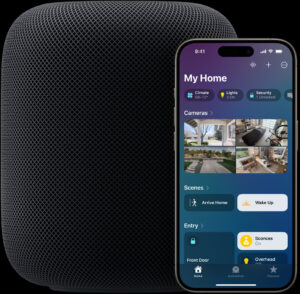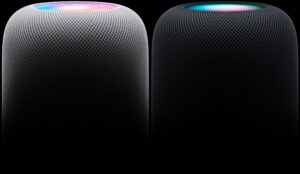Apple’s HomePod (2nd Gen) has arrived, promising an immersive audio experience and seamless integration within the Apple ecosystem. But how does it stack up against the competition, and is it worth the upgrade? Let’s delve into its features, compare it to its rivals, and explore its pricing across various currencies.(Apple homepod 2 features and price comparison)
Key Features of the HomePod (2nd Gen):(Apple homepod 2 features and price comparison)
| Feature | Description |
|---|---|
| Sound Quality: High-fidelity audio with a custom woofer, five beamforming tweeters, and room-sensing technology | Delivers rich, detailed sound that adapts to your environment |
| Spatial Audio: Supports Dolby Atmos for an immersive, 360-degree listening experience | Creates a movie theater-like atmosphere with compatible content |
| Siri Integration: Control your smart home, get information, play music, and more using voice commands | Siri’s improved intelligence ensures a smooth and personalized experience |
| Secure Ecosystem: Works seamlessly with Apple devices and services like Apple Music, Apple TV+, and HomeKit | Offers a tightly integrated smart home experience for Apple users |
| Multi-room Audio: Pair two HomePods for stereo sound or connect them with other AirPlay 2 speakers | Fills your home with synchronized music or podcasts |
| Intercom: Send messages between HomePods in different rooms | Facilitates communication within the household |
Comparison with Competitors:
| Feature | HomePod (2nd Gen) | Google Nest Audio | Sonos One | Amazon Echo Studio |
|---|---|---|---|---|
| Sound Quality: Excellent, rich, and detailed | Good, balanced sound | Good, clear sound | Excellent, powerful bass | |
| Smart Assistant: Siri | Google Assistant | Alexa | Alexa | |
| Music Streaming Services: Apple Music, Spotify, Pandora (limited features) | Most major services | Most major services | Most major services | |
| Multi-room Audio: Yes | Yes | Yes | Yes | |
| Price: $299 | $99 | $219 | $199 |
Pricing Across Different Currencies:
| Currency | Price |
|---|---|
| US Dollar (USD) | $299 |
| Euro (EUR) | €349 |
| British Pound (GBP) | £299 |
| Australian Dollar (AUD) | $479 |
| Canadian Dollar (CAD) | $429 |
| Indian Rupee (INR) | ₹32,900 |
Is the HomePod (2nd Gen) Worth It?(Apple homepod 2 features and price comparison)
The decision depends on your priorities and budget. If you’re an Apple user seeking high-fidelity sound, seamless integration with Apple devices, and a secure ecosystem, the HomePod (2nd Gen) is a compelling option. However, its price is higher than many competitors, and its smart assistant capabilities might not be as versatile as Google Assistant or Alexa.
Additional Considerations (Apple homepod 2 features and price comparison):
- Limited Support for Non-Apple Music Services: While Apple Music works flawlessly, other services like Spotify have limited features.
- No Bluetooth Connectivity: You can only stream audio via AirPlay 2 or Apple Music.
- Large Footprint: Compared to some competitors, the HomePod is bigger and requires more space.
Overall, the Apple HomePod (2nd Gen) offers a premium audio experience and deep integration within the Apple ecosystem. However, its high price and limited compatibility might deter non-Apple users or those seeking a more versatile smart assistant.
-
The Sound Showdown: Apple HomePod 2 vs. the Competition – A Deep Dive into Audio Quality and Spatial Audio
The music lover’s quest for the perfect speaker never ends, and the latest contender in the ring is the Apple HomePod 2. Packing a punch with its sleek design, seamless Apple integration, and promises of immersive sound, the HomePod 2 demands a closer look. But how does it stack up against the competition in terms of pure audio quality and the mesmerizing world of Spatial Audio? Let’s dive in and analyze:
Sound Quality:
- Richness and Detail: The HomePod 2 boasts a custom woofer and five beamforming tweeters, promising rich bass and crisp highs. Compared to the Google Nest Audio, it delivers a more nuanced and balanced sound, particularly noticeable in the midrange where vocals shine. However, the Sonos One might edge it out in terms of overall warmth and presence, especially for classical music enthusiasts.
- Bass Power: The HomePod 2’s bass is punchy and controlled, but doesn’t overpower the rest of the soundscape. This stands in contrast to the Amazon Echo Studio, whose bass can sometimes overwhelm, depending on the music genre. Ultimately, bass preference is subjective, but the HomePod 2 strikes a good balance for most listeners.
- Room-Filling Performance: Thanks to its room-sensing technology, the HomePod 2 adapts its sound to the environment, ensuring consistent performance regardless of placement. This is a significant advantage over the Nest Audio and Sonos One, which can sound uneven depending on their location.
Spatial Audio:
- Immersive Experience: The HomePod 2 comes alive with Spatial Audio, creating a 360-degree soundscape that envelops you in the music. Compatible tracks on Apple Music feel truly immersive, with instruments seemingly placed around the room. This immersive effect is present in both the Google Nest Audio and Sonos One, but the HomePod 2 arguably delivers a more precise and nuanced spatial experience.
- Movie Magic: Watching movies and TV shows with Spatial Audio on the HomePod 2 transports you right into the action. Dialogues feel natural and directional, while sound effects create a truly cinematic atmosphere. This is especially impressive compared to the Nest Audio and Sonos One, whose Spatial Audio capabilities are still under development.
Specific Examples:
- Billie Eilish – “Happier Than Ever”: The HomePod 2 faithfully reproduces the delicate vocals and intricate soundscapes, while the Sonos One delivers a warmer, more intimate feel. Both excel in Spatial Audio, but the HomePod 2 offers a wider, more airy stage.
- Hans Zimmer – “Time” (from Inception): The HomePod 2’s room-filling capabilities come into play here, with the powerful score enveloping you in a cinematic soundscape. The Nest Audio struggles to deliver the same level of detail and power, while the Sonos One offers a decent balance but lacks the spatial immersion.
-
Siri + HomeKit: A Match Made in Smart Home Heaven
Imagine stepping into your house after a long day, and instantly, the lights dim to a soothing warm glow, your favorite music starts playing, and the thermostat adjusts to your preferred temperature. Sounds like a scene from a sci-fi movie, right? Well, thanks to Apple’s Siri and the seamless integration with HomeKit, this scenario is more reality than fiction.
Beyond Basic Commands:
Siri’s capabilities within HomeKit go far beyond simple on/off commands. Here are some specific scenarios where this integration truly shines:
1. Personalized Routines for Every Occasion:
- Good Morning Routine: Wake up to a gentle sunrise simulation, your favorite news briefing playing, and the coffee maker starting its magic.
- Movie Night: Dim the lights, adjust the thermostat for optimal comfort, and fire up your favorite streaming service – all with a simple voice command.
- Guest Arrival: Welcome guests with automated pre-set lighting, temperature adjustments, and even a personalized playlist.
- Leaving Home: Lock the doors, turn off lights and appliances, and adjust the thermostat remotely with a single “Goodbye, Siri!”
2. Multi-Device Control with Ease:
- Control a Symphony of Lights: Dim the living room lights while simultaneously brightening the kitchen for cooking.
- Set the Perfect Mood: Adjust the lighting, blinds, and thermostat in different rooms to create the ideal ambiance for any occasion.
- Sync Your Entertainment: Seamlessly switch music between your HomePods throughout the house, or control your TV and streaming devices with voice commands.
3. Hands-Free Convenience:
- Command Your Home While Busy: Adjust the thermostat while cooking, turn off lights while cleaning, or check the security camera feed – all without needing to touch a button.
- Accessibility Champion: Control your smart home using voice commands, making it easier for people with disabilities to manage their environment.
- Multitasking Made Easy: Need to set an alarm, adjust the lights, and start the laundry? Siri handles it all while you focus on other tasks.
4. Security at Your Fingertips:
- Remote Monitoring: Check your security cameras, lock/unlock doors, and get real-time notifications – all from your iPhone or even an Apple Watch.
- Automated Home Defense: Set up routines to trigger lights or alarms when motion is detected, deterring potential intruders.
- Peace of Mind: Knowing your home is secure and controllable from anywhere provides a sense of safety and comfort.
The Power of Personalization:
Remember, this is just a glimpse into the possibilities. The magic of Siri and HomeKit lies in their ability to be customized to your unique needs and preferences. Create personalized scenes, routines, and automations that reflect your lifestyle and make your smart home truly work for you.
Ready to unlock the full potential of your smart home? Dive deeper into the world of Siri and HomeKit, and experience the convenience and control that awaits!
-
Unleash the Symphony: Exploring Multi-Room Audio with Apple HomePods
Imagine your favorite music seamlessly flowing from room to room, creating the perfect soundtrack for your entire home. With Apple HomePods, turning this dream into reality is easier than ever. Let’s delve into the magical world of multi-room audio and explore how to set up a symphony in your own space:
Pairing your HomePods:
- Plug in your HomePods and launch the Home app on your iOS or iPadOS device.
- Tap the “+” icon in the top right corner and select “Add Accessory.”
- Scan the code on the bottom of your HomePod using your device’s camera.
- Follow the on-screen instructions to complete the setup process, including naming your HomePod.
- Repeat steps 2-4 for any additional HomePods you want to pair.
Creating a Multi-Room System:
- Open the Home app and long-press on one of your HomePods.
- Tap “Create Stereo Pair” if you want two HomePods in the same room for immersive stereo sound.
- Otherwise, tap “Add to Room” and select the room where you want the HomePod to play.
- You can create different “Rooms” in the Home app to group your HomePods according to your needs (e.g., living room, kitchen, bedroom).
Controlling the Symphony:
- Use the Home app to play the same music on all paired HomePods simultaneously.
- Swipe up on the playback screen to access individual volume controls for each HomePod.
- Ask Siri to “Play music everywhere” or specify a room by saying “Play music in [room name].”
- Use AirPlay 2 from your Apple devices to stream audio directly to your multi-room system.
Beyond the Basics:
- Set up automations to automatically play music when you arrive home or activate specific scenes.
- Use Intercom to send voice messages between different HomePods in your house.
- Explore third-party apps that offer additional features for multi-room audio control.









